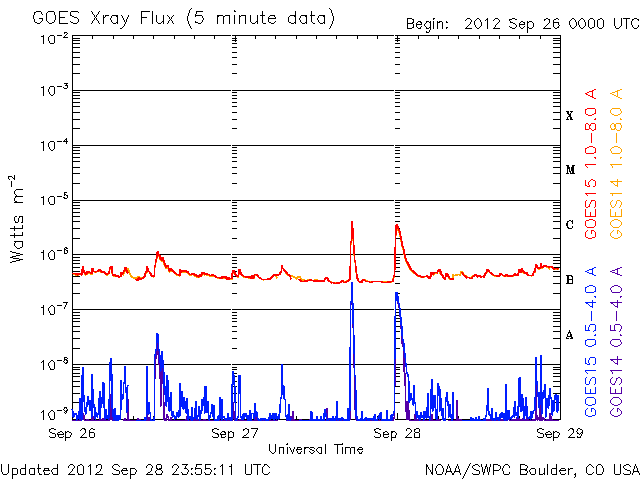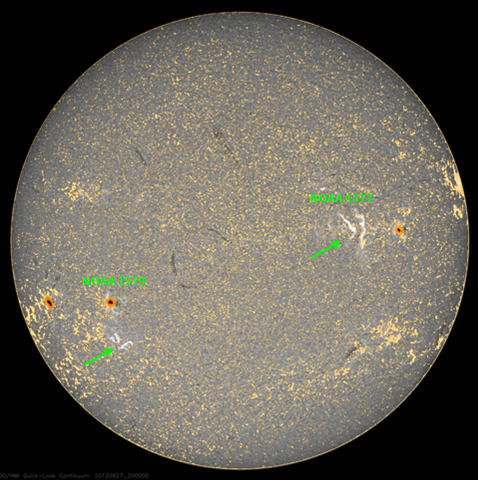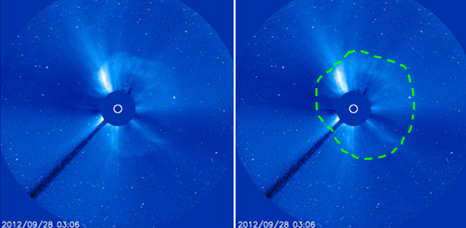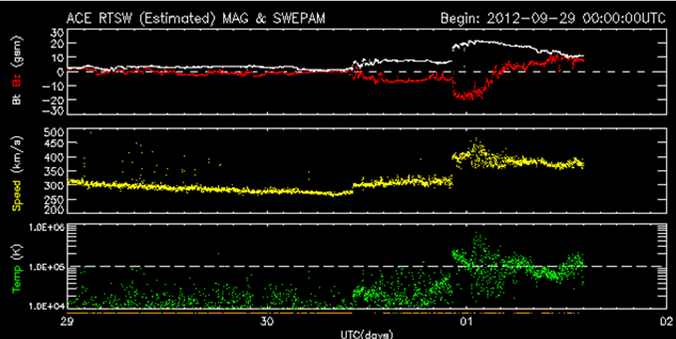
The Solar-Terrestrial Centre of Excellence (STCE) is a collaborative network of the Belgian Institute for Space Aeronomy, the Royal Observatory of Belgium and the Royal Meteorological Institute of Belgium.
 |
Published by the STCE - this issue : 4 Oct 2012. The Solar-Terrestrial Centre of Excellence (STCE) is a collaborative network of the Belgian Institute for Space Aeronomy, the Royal Observatory of Belgium and the Royal Meteorological Institute of Belgium. |
| Archive of the newsletters | Subscribe to this newsletter by mail |
On 27 September, the Sun produced 2 almost identical, small solar flares: A C4.4-flare peaking at 17:20UT, and a C3.7-flare at 23:57UT. However, except for their near-equal strength, these eruptions differed quite a bit from each other, and they had also a very different impact on Earth.




This week, the Sun's appearance was dominated by 2 single sunspots on the southern hemisphere, NOAA 1579 and NOAA 1582 (the biggest of the two). See USET white light image underneath (http://www.sidc.oma.be/uset/ ).
As such, the flaring activity was rather low during the week, with mostly C-class flares and a M1.3 class flare on September 30, 04:33UT (peak time), which occurred in NOAA Active Region 1583, close to the northwest limb.
However, the most significant event was a C3.7 flare, taking place in NOAA Active Region 1577, on September 27, 23:36UT (peak time). It triggered a mild proton event (>10 MeV protons) and was associated with a coronal EUV wave and a halo Coronal Mass Ejection (CME).

| DAY | BEGIN | MAX | END | LOC | XRAY | OP | 10CM | TYPE | Cat | NOAA | NOTE |
| 30 | 0427 | 0433 | 0442 | N13W75 | M1.3 | 0 | 1583 |
| LOC: approximate heliographic location | TYPE: radio burst type |
| XRAY: X-ray flare class | Cat: Catania sunspot group number |
| OP: optical flare class | NOAA: NOAA active region number |
| 10CM: peak 10 cm radio flux |
This week, the Sun's activity level was *Low* with a minimum (*Very Low*) on Friday. Then, activity increased with more than a dozen C-flares both on Saturday and Sunday, as well as an M1.3 flare (*Moderate*) on Sunday, near the west limb.
The M1.3 flare impacted the green area shown in the picture below. It was closely followed by a C2.9 flare, which triggered the transfer of some material from NOAA Active Region 1577, located north of the equator, towards NOAA Active Region 1576, south of the equator (see red circle in the picture below).

In order to view the activity of this week in more detail, we suggest to go to the following website from which all the daily (normal and difference) movies can be accessed: http://proba2.oma.be/ssa.
This page also lists the recorded flaring events.
Geomagnetic activity was low during the week. The peak of activity was observed on September 30.
Starting with a weak shock signature observed by ACE around 10:00UT, it was soon followed by a strong shock around 22:00UT from the arrival of the aforementioned CME. This resulted in unsettled to active conditions late on September 30, and evolving into storm conditions at planetary levels early on 1 October.
The SALE Executive is pleased to announce that a set of high level talks on
various aspects of the energetic particle radiation hazard to aviation crews
and personnel aboard spacecraft in LEO will be presented at a meeting of the
Spacecraft, Aircraft and Launcher Environments group during Space Weather
Week in Brussels, Belgium (8 November, 2012).
Abstracts of these talks are attached and EVERYONE is cordially invited to
attend on this very special occasion.
http://www.spaceweather.eu/en/repository/show?id=252
Invited talk in the session Solar Magnetism and the Solar Cycle.
http://www.spaceweather.eu/en/repository/show?id=253
Presentatie over de 24ste zonnecyclus voor leden van de volkssterrenwacht Urania in het kader van hun wekelijkse voordrachten. Een basiskennis is vereist.
http://www.spaceweather.eu/en/repository/show?id=254
Presentatie over de zon voor leden van de volkssterrenwacht MIRA in het kader van een cursus sterrenkunde. Een basiskennis is vereist.
http://www.spaceweather.eu/en/repository/show?id=255
Talk in the session Solar magnetism and the solar cycle
http://www.spaceweather.eu/en/repository/show?id=256
Talk in the session Solar Magnetism and the Solar Cycle
http://www.spaceweather.eu/en/repository/show?id=257
Talk in the session Solar Magnetism and the Solar Cycle
http://www.spaceweather.eu/en/repository/show?id=258
Talk in the session Solar Magnetism and the Solar Cycle
http://www.spaceweather.eu/en/repository/show?id=259
Talk in the session Solar Magnetism and the Solar Cycle
http://www.spaceweather.eu/en/repository/show?id=260
Talk in the session Processes of slow/steady energy release in the solar atmosphere and heliosphere
http://www.spaceweather.eu/en/repository/show?id=261
Talk in the session Processes of slow/steady energy release in the solar atmosphere and heliosphere
http://www.spaceweather.eu/en/repository/show?id=262
Talk in the session Processes of slow/steady energy release in the solar atmosphere and heliosphere
http://www.spaceweather.eu/en/repository/show?id=263
Talk in the session Processes of slow/steady energy release in the solar atmosphere and heliosphere
http://www.spaceweather.eu/en/repository/show?id=264
Talk in the session Processes of slow/steady energy release in the solar atmosphere and heliosphere
http://www.spaceweather.eu/en/repository/show?id=265
Talk in the session Processes of slow/steady energy release in the solar atmosphere and heliosphere
http://www.spaceweather.eu/en/repository/show?id=266
Invited talk in the session Processes of slow/steady energy release in the solar atmosphere and heliosphere
http://www.spaceweather.eu/en/repository/show?id=267
Invited talk in the session Processes of slow/steady energy release in the solar atmosphere and heliosphere
http://www.spaceweather.eu/en/repository/show?id=268
Talk in the session Processes of slow/steady energy release in the solar atmosphere and heliosphere
http://www.spaceweather.eu/en/repository/show?id=269
Invited talk in the session Eruptive processes in the solar atmosphere and their manifestations in the heliosphere
http://www.spaceweather.eu/en/repository/show?id=270
Talk in the session Eruptive processes in the solar atmosphere and their manifestations in the heliosphere
http://www.spaceweather.eu/en/repository/show?id=271
Talk in the session Eruptive processes in the solar atmosphere and their manifestations in the heliosphere
http://www.spaceweather.eu/en/repository/show?id=272
Invited talk in the session Eruptive processes in the solar atmosphere and their manifestations in the heliosphere
http://www.spaceweather.eu/en/repository/show?id=273
Talk in the session Eruptive processes in the solar atmosphere and their manifestations in the heliosphere
http://www.spaceweather.eu/en/repository/show?id=274
Talk in the session Eruptive processes in the solar atmosphere and their manifestations in the heliosphere
http://www.spaceweather.eu/en/repository/show?id=275
Talk in the session Eruptive processes in the solar atmosphere and their manifestations in the heliosphere
http://www.spaceweather.eu/en/repository/show?id=276
Talk in the session Eruptive processes in the solar atmosphere and their manifestations in the heliosphere
http://www.spaceweather.eu/en/repository/show?id=277
Invited talk in the session Eruptive processes in the solar atmosphere and their manifestations in the heliosphere
http://www.spaceweather.eu/en/repository/show?id=278
Talk in the session Eruptive processes in the solar atmosphere and their manifestations in the heliosphere
http://www.spaceweather.eu/en/repository/show?id=279
Talk in the session Eruptive processes in the solar atmosphere and their manifestations in the heliosphere
http://www.spaceweather.eu/en/repository/show?id=281
Talk in the session Eruptive processes in the solar atmosphere and their manifestations in the heliosphere
http://www.spaceweather.eu/en/repository/show?id=282
Talk in the session Data assimilation, visualization and analysis
http://www.spaceweather.eu/en/repository/show?id=283
Invited talk in session Data assimilation, visualization and analysis
http://www.spaceweather.eu/en/repository/show?id=285
Talk in session Data assimilation, visualization and analysis
http://www.spaceweather.eu/en/repository/show?id=286
Talk in session Data assimilation, visualization and analysis
http://www.spaceweather.eu/en/repository/show?id=287
Talk in session Data assimilation, visualization and analysis
http://www.spaceweather.eu/en/repository/show?id=288
Invited talk in session Data assimilation, visualization and analysis
http://www.spaceweather.eu/en/repository/show?id=289
Invited talk given in the Session Solar Magnetism and the solar cycle
http://www.spaceweather.eu/en/repository/show?id=290
Talk in the session Eruptive processes in the solar atmosphere and their manifestations in the heliosphere.
http://www.spaceweather.eu/en/repository/show?id=291
Talk in session Data assimilation, visualization and analysis
http://www.spaceweather.eu/en/repository/show?id=292
Talk given in the Session Processes of slow/steady energy release in the solar atmosphere and heliosphere
http://www.spaceweather.eu/en/repository/show?id=293
Invited talk in the session Eruptive processes in the solar atmosphere and their manifestations in the heliosphere
http://www.spaceweather.eu/en/repository/show?id=294
Talk in the session Eruptive processes in the solar atmosphere and their manifestations in the heliosphere
http://www.spaceweather.eu/en/repository/show?id=295
Talk in the session Eruptive processes in the solar atmosphere and their manifestations in the heliosphere
http://www.spaceweather.eu/en/repository/show?id=280
Start : 2012-10-08 - End : 2012-10-12
Initiated in 1990, the United Nations Basic Space Science
Initiative (UNBSSI) has contributed to the international and
regional development of astronomy and space science through annual
workshops organized under the umbrella of the United Nations,
focusing specifically on the International Heliophysical Year 2007
(IHY, 2005-2009) and the International Space Weather
Initiative (ISWI, 2010-2012).
UNBSSI has led to the establishment of planetariums, astronomical
telescope facilities, and IHY/ISWI instrument arrays worldwide,
particularly in developing nations. ISWI is envisioned to continue
the tradition of IHY in the worldwide deployment of space weather
monitoring instrument arrays. To
date, ISWI contributes to the observation of space weather
through 18 instrument arrays with
close to 1000 operating instruments in more than 100 nations
supported by designated national ISWI coordinators.
The first workshop on ISWI was held in Helwan, Egypt and hosted
by the Helwan University, Egypt, in 2010, particularly for the
benefit of nations in Western Asia. In 2011 the United
Nations/Nigeria Workshop on ISWI was hosted by the Centre for Basic
Space Science of the University of Nigeria at Nsukka, Nigeria,
particularly for the benefit of nations in Africa. The third ISWI
workshop will be hosted by Ecuador in 2012 for the region of Latin
America and the Caribbean.
Website:
http://iswiecuador.epn.edu.ec/
Start : 2012-10-22 - End : 2012-10-24
2012 - 2013 is expected to be years with high solar activity.
This can trigger larger solar storms which can generate geomagnetic
induced currents (GIC
) on the earth. GIC
can affect the normal operation of
specific industrial operations and critical infrastructure (e.g
power grids, telecom, navigation systems, etc).
During space weather
events, like solar storms, electric
currents in the magnetosphere
and ionosphere
experience large variations, which
manifest also in the earth's magnetic field. These variations
induce currents (GIC
) in conductors operated on the
surface of the earth. Electric transmission grids and buried
pipelines are common examples of such conductor systems. GIC
can cause problems, such as
increased corrosion of pipeline steel and may disturb and possible
damaged high-voltage power transformers and it can also have
damaging effects on communication systems, navigation systems and
oil and gas operations.
Vulnerable industries are the oil and gas industry, railways,
telecommunication industry, navigation industry and not at least
the society, which is very vulnerable concerning short or long term
interruption of critical infrastructure.
The conference will focus on increasing the general knowledge of
solar storms, space weather
and GIC
and the possible consequences for
different industries and critical infrastructure, and look into
reasonable means of protection, and consider possible early warning
solutions.
Website:
http://www.tiems.info/about-tiems/oslo-conference-2012.html
Start : 2012-11-05 - End : 2012-11-09
We are pleased to announce that the Ninth European Space Weather
Week will take place at the
Académie Royale de Belgique, Brussels, Belgium between 5
and 9 November 2012.
This meeting is being jointly organised by the Solar-Terrestrial
Centre of Excellence (STCE), ESA
, the SWWT and the COST ES0803
communities. The local organisation is done by the STCE. This event
will continue to build on the advances made during the first eight
European Space Weather
Weeks held between 2004 and
2011.
Website:
http://www.sidc.be/esww9/
Start : 2012-11-06 - End : 2012-11-09
The International Symposium on Solar-Terrestrial Physics will be
held during November 6 - 9, 2012 at the Indian Institute of
Science, Education and Research, Pune, India. This meeting under
the aegis of the SCOSTEP is expected to draw leading scientists
from around the world in the increasingly important,
interdisciplinary fields of Solar activity and its impact on
geospace and life on the Earth. With major observational solar
facilities being planned in India, this meeting is especially
pertinent in the Indian context.
The meeting is expected to involve professional scientists as
well as graduate students, and will have a mixture of invited and
contributed talks and posters. There will also be a one-day
tutorial for the benefit of young people beginning work in the
field of solar-terrestrial physics.
Website:
http://www.iiserpune.ac.in/~isstp2012/
Start : 2012-11-12 - End : 2012-11-16
As we emerge from one of the deepest and longest solar minima on
record, with a new and powerful eye on the Sun -SDO- we invite all
those with an interest is solar activity to gather in beautiful
Palm Cove, Australia to review and assess our current knowledge and
understanding of our magnetic star
, and to experience the awe and
wonder of a total solar eclipse on November 14, 2012.
Website:
http://moca.monash.edu/eclipse/
Start : 2012-11-13 - End : 2012-11-13
For more information:
http://eclipse.gsfc.nasa.gov/OH/OH2012.html#SE2012Nov13T
Start : 2012-11-15 - End : 2012-11-16
The European Commission will organise the 'Let's embrace
space - FP7 Space Conference 2012', in cooperation with the Cypriot
EU Presidency, on 15 and 16 November 2012 in Larnaca, Cyprus.
This scientific conference will present the current status and
results of the 3rd call of FP7 space research, and also discuss
future options for European research in the space field. In doing
so, the conference will aim at demonstrating the evolution and use
of space tools for a sustainable economic and environmental
development in a European and global context.
Website:
http://www.fp7-space.eu/news-119.phtm
Start : 2012-11-20 - End : 2012-11-23
Nobeyama Radioheliograph (NoRH) has been observing the Sun since
1992. This year is the 20th year of science operation. Instruments
are still in good shape and producing images of the Sun every day
with the same quality as the beginning. Due to the nature of the
instrument and long and uniform observations, data can be used for
wide variety of solar physics and also for solar terrestrial
physics. To mark the 20 years of operation, we will organize a
symposium to summarize what has been done with NoRH and to discuss
what we should do in the future. Papers to be presented in the
meeting will be mainly concerned with the results from NoRH and
future plans.
Website:
http://st4a.stelab.nagoya-u.ac.jp/SPRO2012/
Start : 2012-11-30 - End : 2012-12-05
The overarching objective of the conference is to examine the
connections amongst the phenomena that lead to solar eruptive
events. The current state of themes includes:
* Measuring the Coronal Magnetic Field;
* Connections to, and Reactions of, the Large-Scale Corona;
* Large-scale Magnetic Connectivity of Active Regions;
* Transfer of Energy to, and Storage of Energy in, the
Corona;
* The High-Energy Particle - Flare - CME
connection.
Working groups will address topics such as:
* Energy Transfer throughout a Solar Eruptive Event;
* Global Energetics of an Ensemble of Events;
* Coronal Influences to the Lower Atmosphere;
* CME
Initiation and Type II Bursts;
* The Release of Energetic Particles in the Low Corona;
* Flows vs. Waves;
* Microflares/Nanoflares.
Website:
http://hessi.ssl.berkeley.edu/petaluma/index.shtml
Start : 2013-01-13 - End : 2013-01-19
Information coming soon!
Website:
http://sd-www.jhuapl.edu/Aurora/ESSE/index.html
Start : 2013-03-03 - End : 2013-03-08
Living With a Star
's Solar Dynamics Observatory
invites you to its 2013 Science Workshop to be held March 3-8, 2013
at the Hyatt Regency Chesapeake Bay in Cambridge, MD
(http://chesapeakebay.hyatt.com/). The workshop is a follow-on to
the 'Many Spectra of Solar Activity' workshop held May 1-5, 2011 in
Squaw Valley, CA.
Scientific sessions will feature a broad spectrum of science
topics fundamental to SDO's science investigations:
Atmospheric Imaging Assembly (AIA), EUV Variability Experiment
(EVE), and Helioseismic and Magnetic Imager (HMI), as well as the
overlap between SDO and other scientific missions and
activities.
Website:
http://lws-sdo-workshops.org/
Start : 2013-03-10 - End : 2013-03-15
Spacecraft observations have established that all magnetized
planets in our solar system interact strongly with the solar wind
and possess well-developed
magnetotails. Magnetotails are the site for many dynamic processes
critical to the circulation of mass, energy and magnetic flux. The
great differences in solar wind
conditions, planetary rotation
rates, ionospheric conductivity, and physical dimensions from
Mercury's small magnetosphere
to the giant magnetospheres of
Jupiter and Saturn provide an outstanding opportunity to extend our
understanding of the influence of these factors. Therefore, this
Chapman conference will provide a forum in which various
communities can come together and discuss recent achievements of
observational, theoretical, and modeling studies with the objective
to develop a deeper understanding of fundamental properties and
processes of planetary magnetotails through a comparative
examination.
Start : 2013-05-10 - End : 2013-05-10
For more information:
http://eclipse.gsfc.nasa.gov/SEplot/SEplot2001/SE2013May10A.GIF
Start : 2013-06-10 - End : 2013-06-16
Topics:
* Prominences : formation, dynamics
* Prominence plasma properties, including prominence
seismology
* Magnetic field : measurements, topology, support
* Large-scale patterns and cyclic evolution
* Prominence destabilization, CMEs, reconstruction in 3D
* ICMEs in the heliosphere, magnetic clouds; their impact on the
Earth environment
* Stellar quiescent and eruptive prominences and stellar CME
* Requirements for future instrumentation and prospects for
future missions
Website:
http://www.iau.org/science/meetings/future/symposia/1065/
Start : 2013-06-24 - End : 2013-06-29
Solar cycle 24 has opened a new era in solar radio physics as we
now have instruments that can probe solar processes from
sub-millimeter to kilometer waves. ALMA and LOFAR are entering
full-operation state and observations of the Sun will be made in
the near future.
At the same time extensive use is being made of radio
spectrometers in space, STEREO
/WAVES and Wind
-WAVES, and existing and upgraded
ground-based instruments like Nobeyama Radioheliograph, Nancay
Radioheliograph, Ratan, SSRT, and many others. These instruments
provide data that enable studies of both energetic particles and
thermal plasma
, enhancing our knowledge of solar
eruptions and acceleration and propagation of particles, all
through the solar chromosphere
and corona and into interplanetary
space.
The CESRA 2013 Workshop will highlight these new observational
capabilities and discuss the theoretical issues connected to solar
radio emission and interplanetary radio physics.
Website:
http://wave.asu.cas.cz/cesra2013/
Start : 2013-07-08 - End : 2013-07-11
The 2013 meeting of the AAS/SPD will be July 8-11 (and possibly
July 12), hosted by the Solar Physics Group of Montana State
University, in Bozeman, Montana.
Website:
http://solar.physics.montana.edu/SPD/
Start : 2013-11-03 - End : 2013-11-03
For more information:
http://eclipse.gsfc.nasa.gov/SEplot/SEplot2001/SE2013Nov03H.GIF